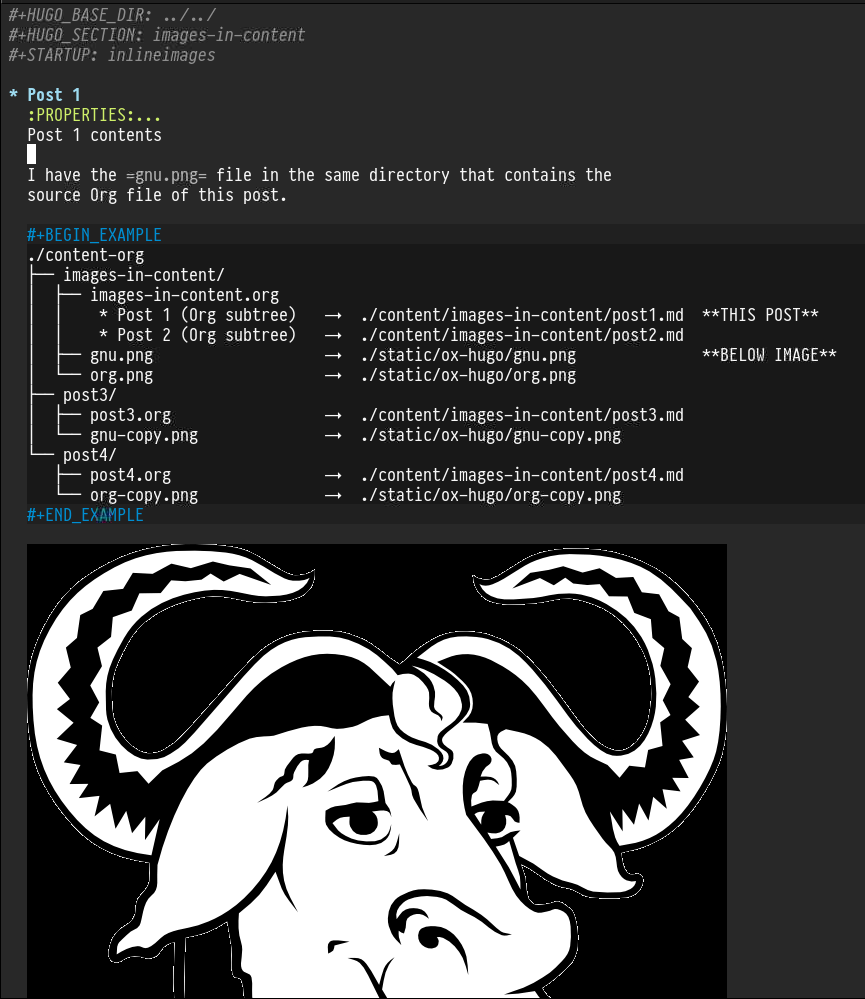Conventionally any static content for a Hugo site, like images, PDF
files, and other attachments are put in the site static/
directory. Files in that directory are served at the site root when
the Hugo publishes that site. So all the content in there can be
accessed using the root prefix /. So a static/foo.png file can be
accessed at /foo.png.
More detail for this conventional approach can be found in the documentation for referencing files in static directory .
Images and Regular Pages #
OK, so with that short intro out of the way, ox-hugo supports
putting the attachment files in the same directory as the source Org
files!
In the below example, the left hand side shows the Org content and
attachment file organization that the user would need to do
manually. And the right hand side shows the structure that ox-hugo
will generate in the content/ and static/ (the conventional way
discussed above) directories.
./content-org
├── images-in-content/
│ ├── images-in-content.org
│ │ * Post 1 (Org subtree) → ./content/images-in-content/post1.md
│ │ * Post 2 (Org subtree) → ./content/images-in-content/post2.md
│ ├── gnu.png → ./static/ox-hugo/gnu.png
│ └── org.png → ./static/ox-hugo/org.png
├── post3/
│ ├── post3.org → ./content/images-in-content/post3.md
│ └── gnu-copy.png → ./static/ox-hugo/gnu-copy.png
└── post4/
├── post4.org → ./content/images-in-content/post4.md
└── org-copy.png → ./static/ox-hugo/org-copy.png
Have a look at the
content-org/images-in-content/images-in-content.org file for an
example of how to reference same-directory files (gnu.png and
org.png in this example) in an Org file (Hint: Just as you would do
in a normal Org file).
The benefit of this same-directory-attachment approach is that you
don’t need to use any directory prefix to reference those files
(example: [[file:gnu.png]]). When ox-hugo exports those posts though,
the images are auto-copied to the static/ox-hugo/ directory1
and /ox-hugo/ prefix is added to those file references in the
exported Markdown files.
Also as the image file references are valid within the Org file, you can see those images inline too!

Examples #
Whether you prefer the subtree-based approach or file-based approach
for writing your posts in Org, there are examples for both in the
ox-hugo test suite:
Images and Page Bundles #
See Hugo Bundle section on how to define
those via ox-hugo.
Only for page bundles, when a link points to a local attachment, and the image path contains the hugo bundle name, following attachment copying rules apply:
- Assume that the bundle is a Leaf Bundle and its name is
bundle-1(:EXPORT_HUGO_BUNDLE: bundle-1) and that the image (attachment) path relative to the Org file issome-dir-1/bundle-1/some-dir-2/image.png. - The attachment’s path relative to “bundle-1” is retained and copied to the “bundle-1” directory in the content dir. The path before the “bundle-1” in the attachment path is ignored.
- So after the export, we will see a directory structure like this in
the content dir:
./content .. └── bundle-1 ├── index.md └── some-dir-2/image.png
If the attachment path does not contain the bundle name, it will be
copied as usual to the static/ directory (See the documentation for
referencing files in static directory ).
Examples #
./content-org
├── posts.org
│ * Bundle 1 (Org subtree) → ./content/bundle-1/index.md
│ [[file:bundle-1/image1.png]]
│ [[file:images/bundle-1/image.png]]
│
│ * Bundle 2 (Org subtree) → ./content/bundle-2/index.md
│ [[file:images/bundle-2/some-dir/image.png]]
│
├── bundle-1
│ └── image1.png → ./content/bundle-1/image1.png
└── images/
├── bundle-1
│ └── image2.png → ./content/bundle-1/image2.png
└── bundle-2
└── some-dir
└── image.png → ./content/bundle-2/some-dir/image.png
Another example from the test suite:
-
To understand why the attachment files get copied to the
static/ox-hugo/directory, have a look at the documentation for referencing files outside static directory. ↩︎
